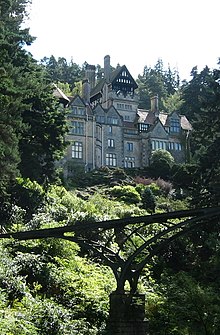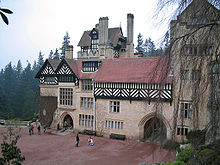Cragside
Cragside is a country house in the municipality Cartington in the English county of Northumberland . It was the first house in the world to be illuminated with electricity from hydropower . The house is located on a rocky slope above a 4 km² wooded park and was the country estate of the armaments manufacturer Lord Armstrong . The house has been managed by the National Trust since 1977 , which opened it to the public in 1979.
Cragside, named after the Cragend Hill above the house, was built in 1863 as a modest, two-story lodge, but later expanded into a fine mansion in a sort of modern Tudor style based on plans by Richard Norman Shaw . The building even once contained an observatory and a science laboratory.
The house, listed by English Heritage as a historical building of the first degree, is surrounded by Europe's largest rock garden , a large number of rhododendrons and a large forest, mostly of conifers . One species of rhododendron is named after Lady Armstrong.
In 2007 Cragside was reopened after a "complete renovation".
Hydropower and electricity
Armstrong had a lifelong interest in electricity and hydropower. In 1868 he built the first machine house. At first it only housed a double-acting water column machine , with which water was pumped from a reservoir into a reservoir 60 m above the house. The stored water was drawn into the house by gravity, where it was used for domestic use and to power a hydraulic elevator , rotisserie in the kitchen, and facilities in the laundry room. The drive of the rotisserie was designed as a Segner water wheel, which functioned like an S-shaped lawn sprinkler . The power was transmitted from the water wheel with shafts and joints under floor boards, around corners and over walls to the rotisserie. The whole thing is seen as a gimmick, as there was hardly any shortage of cheap labor back then. The lift was powered by a jigger - a hydraulic winch that used the principle of the pulley system in the opposite direction.
In 1878 one was in the nacelle Siemens - generator set provided by 6 PS vortex turbine according to a design by James Thomson was driven. This system is considered to be the world's first use of hydropower to generate electricity. A carbon arc lamp in the gallery was operated with the electrical energy obtained, but it emitted much too bright light for this application, smoked and was perceived as unsafe. In December 1880 it was replaced by 45 incandescent lamps in what Joseph Wilson Swan called "the first real installation". It probably consisted of two independently switched circuits - one for all lamps on the upper floor and one for all on the first floor. The lamps in a circle could only be switched on and off together.
In 1886 Armstrong had the Burnfoot Power House ⊙ built, the water from Nelly's Moss Lakes ⊙ 100 m above was processed with a turbine supplied by Gilbert Gilkes, the 10 kW generator came from Crompton . The electricity had to be carried to the house via a 500 m long line.
The electricity consumption in the house continued to rise, so that the Burnfoot Power House had to be expanded by a battery house and a gas engine house by 1895 . In addition, a second generator from Thomas Parker , which was powered by a gas engine, was installed. The batteries were used to cover peak loads, and the gas engine was used when the Nelly's Moss Lakes did not have enough water to operate the turbine due to dry weather. The Tangye gas engine was designed as a horizontal single cylinder engine. The gas for running the engine was supplied via a pipe from the Rothbury municipal gas works . The plant had to be informed before the gas engine started. The London-based company Drake & Goreham had not only installed the gas engine, but also rewired the house so that individual lamps could be switched on and off, not just entire floors.
In 1945 the property was connected to the national supply and the operation of the installation switched to alternating current. In 2006 all the cabling was renewed. In 2014 a new power plant was installed on the site, consisting of a 17 m long Archimedean screw that drives a 12 kW generator. The system can cover approximately 10% of the property's electricity needs.
On TV
Jonathan Meades' documentary series Abroad Again in Britain was about Cragside in episode 2/2005.
Cragside also appeared in an episode of Britain's Hidden Heritage on August 21, 2011 , and in the 2013 series Inside the National Trust presented on ITV by Michael Buerk .
Individual evidence
- ^ Bernard Porter: Cragside . History Today Volume. 45th edition, 01/1995 . Retrieved February 27, 2015.
- ^ Cragside . Images of England ( Memento of the original from March 4, 2016 in the Internet Archive ) Info: The archive link was inserted automatically and has not yet been checked. Please check the original and archive link according to the instructions and then remove this notice. . Retrieved February 27, 2015.
- ↑ The best gardens to see rhododendrons . The Telegraph Online . Retrieved February 27, 2015.
- ↑ Vanessa Thorpe: Restored: the world's first hydroelectric house . guardian.co.uk. March 31, 2007. Accessed February 27, 2015.
- ↑ a b c d e Cragside Northumberland. In: Heritage group website for the chartered institution of building services engineers. Retrieved December 8, 2019 (section Electricity at Cragside ).
- ^ Charlie Pye-Smith: The palace of modern magician . ( hevac-heritage.org ).
- ^ Edward Fisher Bamber (Ed.): The scientific works of C. William Siemens: A collection of papers and discussions . tape III . London: J. Murray, 1889, p. 407 ( archive.org ).
- ^ A b c d Sarah Schmitz, Caroline Rawson: Rewiring 'A Temple to High Victorian Technology'. In: www.buildingconservation.com. Retrieved December 15, 2019 .
- ^ Thomas Parker, Limited. Retrieved December 8, 2019 .
- ↑ Alex Kirby: National Trust lights up historic mansion with hydropower . The Guardian, July 31, 2014 . Retrieved February 27, 2015.
- ↑ BBC One - Britain's Hidden Heritage, Cragside House . bbc.co.uk. Retrieved February 27, 2015.
- ^ National Trust opens its doors for TV show . Telegraph, October 4, 2013 . Retrieved February 27, 2015.
Web links
Coordinates: 55 ° 18 ′ 49 ″ N , 1 ° 53 ′ 8 ″ W.

